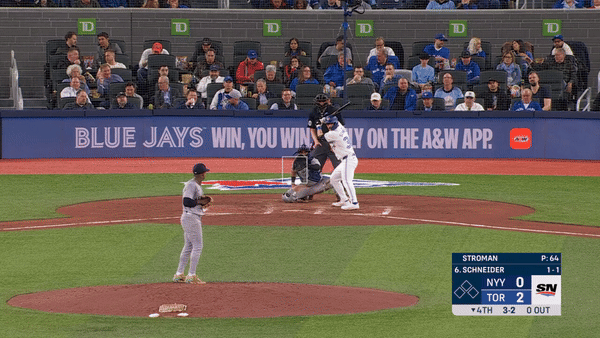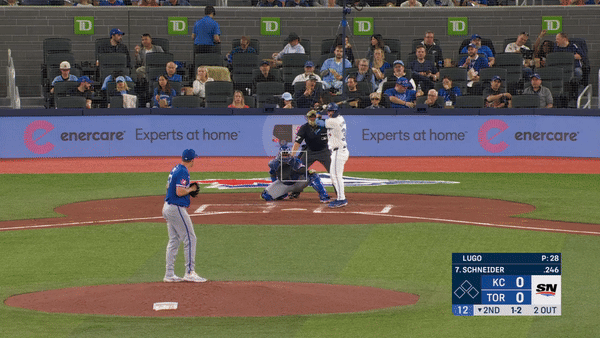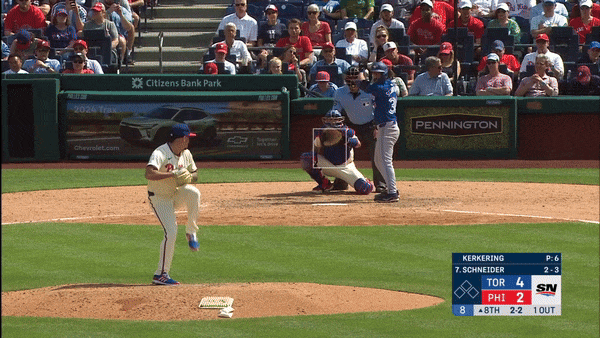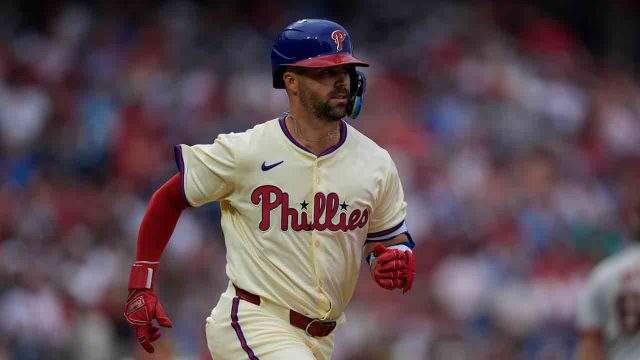PHILADELPHIA — Outside the Toronto Blue Jays baseball operations department, the only person perfectly fine with how Davis Schneider‘s playing time was adjudicated earlier this season may have been Davis Schneider himself.
“Honestly, I think Schneids does a really good job of picking the right matchups for me and putting me in good spots,” the second baseman/outfielder Schneider said of his manager, John Schneider. “I know that’s been a bit of a frowned-upon thing. But I think it does have a positive effect. It builds confidence in me. They’re saying, ‘Hey, we really want you in for this guy.’”
Throughout most of April, that guy typically worked in areas of the zone Schneider’s good at getting his barrel to, with stuff that matches up well with his uppercut swing path. That meant Schneider was in the starting lineup around three times per week, entering late in games as a pinch-hitter if the opposition brought in a lefty to gain platoon advantage on Daulton Varsho, Kevin Kiermaier or Cavan Biggio.
But about a week-and-a-half ago, something changed. Beginning April 27, Schneider started six straight games, and nine of 10. The matchups no longer seemed to matter. Like on Wednesday when Schneider, who had one hit off a right-handed curveball in his big-league career, started against Aaron Nola, a guy with one of the best right-handed curveballs in the sport, over a slumping Biggio, who’s been the plate only five times this month.
And he was no longer being lifted for pinch-hitters late. Over Toronto’s last 10 games, Schneider has the fifth-most plate appearances on the team. Suddenly, he’s an every day, every inning player.
Part of that is the Blue Jays pushing buttons and pulling levers around the margins of their roster in an attempt to kickstart a sputtering offence. Another part is results. Schneider’s hitting .393/.514/.571 over that 10-game span with team highs in doubles (five) and walks (seven).
But it’s also about how Schneider’s getting to those results. Year-over-year, he’s dramatically improved his ability to put his bat on the ball:
Davis Schneider contact rates
|
|
Contact % |
Z-Contact % |
Whiff % |
|
2023 |
64.9% |
67.8% |
37.3% |
|
2024 |
74.1% |
80.3% |
29.1% |
Schneider’s swinging at essentially the same clip he was last year, both inside and outside the zone. But when he does, he’s connecting nearly 10 per cent more often. And he’s particularly improved at making contact within the zone, coming up empty on those pitches over 12 per cent less frequently than he was in 2023.
That makes Schneider much more playable in sub-optimal matchups. It allows him to put more balls in play, spoil more pitches, work deeper plate appearances, have a greater impact wearing down an opposition starter and do something productive even when he’s making an out.
Tuesday’s start against Phillies sinkerballer Cristopher Sanchez was a good example. The Blue Jays looked collectively lost against Sanchez’s barrage of sinkers, changeups, and sliders down in the zone. Of their 33 plate appearances, 18 ended in three pitches or fewer. A third of Toronto’s starters saw single-digit pitches on the night.
And yet, Schneider saw 19 — second only to Vladimir Guerrero Jr. — and worked the team’s second-longest plate appearance of the game. While he went 0-for-3 with a walk, Schneider managed to foul off a team-high five pitches. Only one other Blue Jay — again, Guerrero — fouled off as many as four.
Last season, when the Blue Jays needed a pesky plate appearance, or contact to move a runner over, or someone to get a ball to the outfield for a possible sacrifice fly, Schneider was the worst bet on the team — his contact rate was Toronto’s lowest by over five percentage points. His contact rate in the zone was its lowest by seven. And both those numbers were double-digits below MLB average.
This season, with Schneider making better contact, the Blue Jays feel more confident in his ability to get to pitches he swung through a year ago. It makes a big difference in how he can be deployed — and his impact on an opposition pitcher, which has knock-on effects for his teammates. Schneider’s results are going to wax and wane just like all hitters. He won’t always be as hot as he is right now. But if he can keep his contact where it is, he can continue to contribute even when balls aren’t falling in.
So, how’d he do it? Well, it starts with some recent adjustments to his swing. Here he is facing Marcus Stroman during Mid-April:
And here he is a couple weeks later against Seth Lugo:
That’s a pretty big difference. From the set-up:
To the pre-swing move with his front leg:
After using a more hunched stance with a toe tap throughout last season and early in this one, Schneider is now standing much more upright and utilizing a huge leg kick that Josh Donaldson would describe as a tad aggressive.
The idea is to let Schneider stay on his back leg a tick longer, rather than lunging forward as he did when he toe-tapped, which gives him an improved look at the ball. That’s allowed Schneider to make better swing decisions and, in concert with some bat-path tendencies he’s worked to clean up with Blue Jays hitting coach Matt Hague, better contact.
“I don’t think I’m ever going to be known as a big contact guy. But I’m definitely trying to swing at better pitches to make contact with,” Schneider said. “I’m trying not to chase as much as I did at the end of last year. And part of that is seeing the ball a bit better.”
Schneider’s overall approach numbers have been exceptional ever since he reached the majors, and this year he’s running a chase rate that ranks within the top five per cent of MLB hitters. But he’s right — he did expand the zone a bit more than he typically does over his final 10 games last season, which coincided with a 2-for-35 slump.
Now, it’s a miniscule sample and Schneider’s chase rate during that stretch was still among the five-lowest on his team. But it felt dramatic to him. And entering the off-season, he vowed to correct it.
“I was trying to do a bit too much at the end of last year. That’s why I was chasing. I was trying to force hits,” he said. “But I can’t hit everything. And I’m pretty good at being selective. I’m realizing that. The mindset now is don’t try to hit things I can’t handle.”
The other part of this is Schneider’s bat path, which has been tweaked slightly to let him keep his barrel in the zone longer than he was last season. Hague calls it “depth.” The thinking is the longer your bat’s in the zone, the more room you have for error.
If you’re late, you can still hit a line drive the other way. If you’re early, you have a better chance of keeping the ball fair to your pull side. And if you’re on time, your contact ought to be solid. It’s similar to the swing path adjustments the Blue Jays had Ernie Clement make last year, which suppressed his groundball rate and helped him hit double-digit homers for the first time in his career.
“If you control your barrel, if your barrel’s working the right way, you’re going to make more contact. You’re going to see pitches a little bit better,” Schneider said. “And I think my depth is right where it needs to be right now.”
What’s funny is Schneider used a leg kick throughout his minor-league career until last May, when he was struggling at triple-A and, while working with Hague, adopted the toe tap. Schneider’s numbers took off, he forced his way to the majors, and you know the rest.
But as big-league pitchers got a better sense of what Schneider was trying to do at the plate and began disrupting his timing, Hague suggested he revert to the leg kick.
“My timing was all over the place. Sometimes I was early, sometimes I was late. I was jumping, I was dipping down, I was coming forward,” Schneider said. “The leg kick timing just helps make sure I’m in the right spot every single time. It’s more repeatable for me than the toe tap. It’s more natural. I don’t have to think about it.”
Another benefit: it’s helped Schneider slightly close the hole in his swing at the top of the zone. Staying more upright rather than dipping as he swings keeps Schneider’s eyeline higher and steadier, which has helped him recognize the elevated fastballs that have given him fits throughout his career.
Here’s a good example from Wednesday against the Phillies. In a 2-2 count against Orion Kerkering, Schneider takes a fastball above the zone he frequently chased last year, then fouls off another that came in a little lower and could’ve been a called third strike, ultimately getting to a slider away he takes for ball four:
Last season, Schneider whiffed on 44 per cent of the pitches he went after in the upper third of the zone or higher. So far in 2024, he’s lowered that rate to 36 per cent. Last season, Schneider fouled off only 26 elevated pitches; this year, in only two-thirds as many plate appearances, he’s already fouled off 18.
“When we made the change, I didn’t really realize that was going to happen. But I feel like I’m seeing the high pitch easier and I can get on top of it better,” Schneider said. “That’s helping me a lot. I just trust that I can handle fastballs up a lot better now. I’m not worried about them as much as I was last year.”
Schneider might never hit well against elevated fastballs. But that means pitchers are never going to stop attacking him with them, either. The more often he can spoil those pitches and foul them off, extending his plate appearances and forcing pitchers to throw more pitches, the better chance he’ll give himself of getting to something lower he can handle.
And the easier it’ll be for his team to put him in the lineup every day. Believe it or not, modern managers consider more than just vibes and recent, small-sample results when filling out lineup cards.
Schneider’s big-league career has begun brilliantly. But he’s playing in the most competitive league in the world against organizations with robust scouting and research departments furiously devising ways to get him to make outs. Staying in the majors, and sustaining success there, requires continuous corrections and adaptations.
When the league adjusted to him late last season, Schneider quickly found a way to adjust back. And in the future, he might adjust again. You may not have seen the last of Schneider toe-tapping. What works today might not work tomorrow. Continuing to evolve and find those things that work is what matters.
“A lot of guys don’t necessarily like changing things up,” Schneider said. “And I get it. There’s a reason why people are here. This is the stance and the swing that got them here.
“But, personally, I don’t believe you have to stick with one thing. I feel like sometimes change is good. If it doesn’t work, you just change back. If I don’t feel right that day, why carry that forward and feel bad in the box? Especially when you can switch something up and feel better.”











